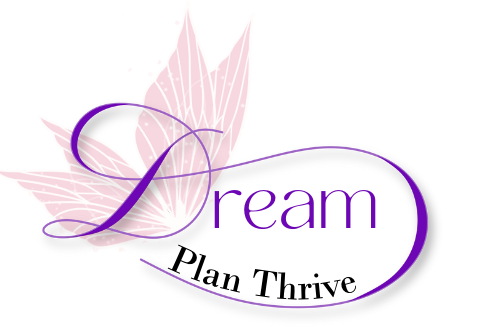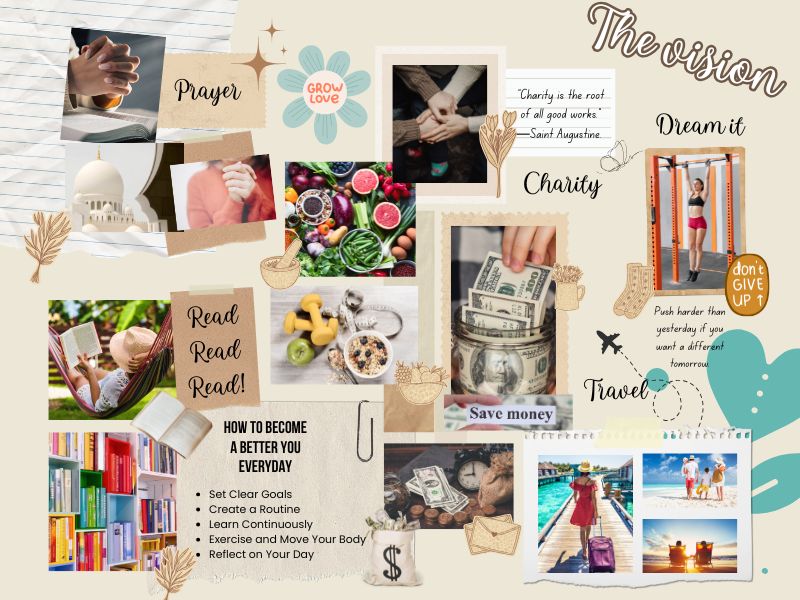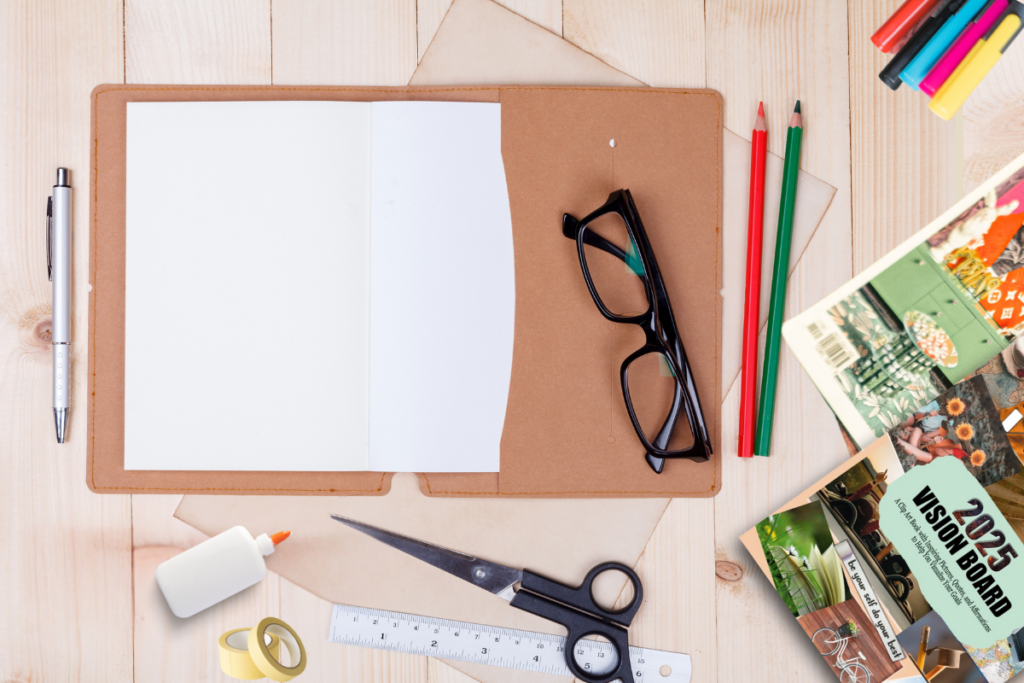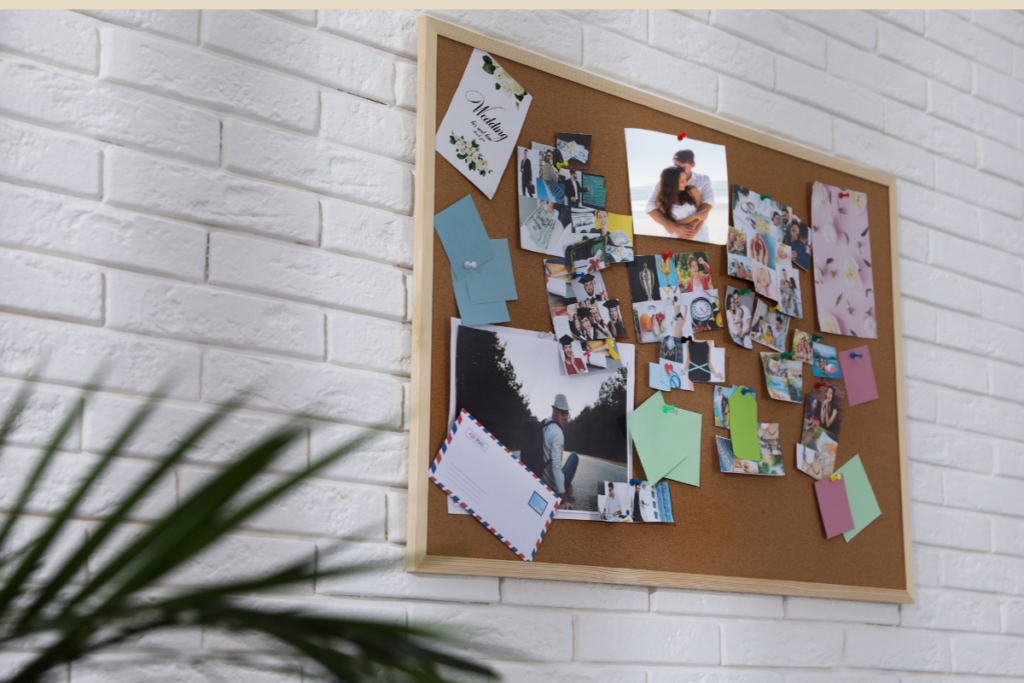Life moves fast these days, and it’s easy to lose sight of your goals and dreams.
A vision board it’s a simple, creative way to stay focused and work toward the life you’ve always imagined.
Whether you’ve never tried creating a vision board before or just want to improve the process, I’m here to walk you through it step by step so you can create a vision board that really works.
Let’s dive in!
This post contains affiliate links, which means I may receive a small commission, at no cost to you, if you make a purchase through a link. Read the full disclosure here.
Why Vision Boards Work
Vision boards help you focus on your goals by using visualization—a proven technique used by successful people. Seeing your dreams daily trains your brain to align your actions with your desires, keeping you motivated and on track.
Step 1: Set Clear Intentions
Before you dive into creating your vision board, it’s important to get clear on what you truly want. Take a moment to reflect on your goals and dreams in different areas of your life, like:
Personal Goals and Development
- Affirmations (e.g., “I am confident,” “I am healthy”)
- Personal growth books or icons
- Images of role models or inspiring figures
- Skills or hobbies you want to master (e.g., painting, cooking, coding)
- Confidence and self-love quotes
- Mindfulness and meditation reminders
- Journals, planners, or other productivity tools
Career and Professional Aspirations
- Dream job or career path
- Awards, accolades, or titles you aim to achieve
- Images of inspiring workspaces or offices
- Professional network growth (e.g., LinkedIn profile goals)
- Financial goals or symbols (e.g., dollar signs, paychecks)
- Certifications, degrees, or courses you want to complete
Health and Fitness
- Fitness goals (e.g., specific weight, lifting targets, running a marathon)
- Healthy foods or meal plans
- Inspirational fitness quotes
- Photos of people doing activities you love (yoga, hiking, sports)
- Wellness rituals (e.g., spa, skincare, journaling)
- Sleep and hydration trackers
Relationships and Social Life
- Happy family or friend group photos
- Wedding or relationship goals
- Positive relationship affirmations (e.g., “I attract healthy and loving relationships”)
- Images of shared activities with loved ones (e.g., vacations, game nights)
- Networking or community events
Travel and Adventure
- Destination bucket list photos
- Maps, globes, or passports
- Activities you want to try (e.g., scuba diving, skiing)
- Phrases like “Adventure Awaits” or “Wanderlust”
- Travel quotes or symbols (e.g., airplane, suitcase)
Financial Goals
- Savings milestones (e.g., $10,000 saved)
- Debt-free trackers
- Investments (e.g., stock symbols, property)
- Dream purchases (e.g., house, car, gadgets)
- Luxury items or experiences
- Passive income symbols (e.g., graphs, online stores)
Spiritual Growth
- Faith-based symbols (e.g., a cross, lotus, Om sign)
- Spiritual quotes or mantras
- Meditation or prayer spaces
- Nature and serenity images (e.g., forests, sunsets)
- Vision of your higher self or enlightened life
Creative Expression
- Artistic projects you want to complete
- Photos or artwork that inspire you
- Tools of your craft (e.g., brushes, cameras, notebooks)
- Inspiring artists or creators
- Words like “Create,” “Inspire,” or “Innovate”
Education and Knowledge
- Schools or universities you want to attend
- Diplomas or certificates you aim to achieve
- Books to read
- TED talks or courses to explore
- New languages or subjects to learn
Dream Lifestyle
- Dream house or apartment
- Interior design styles you admire
- Wardrobe and fashion inspiration
- Morning or evening routine visuals
- Eco-friendly living symbols (e.g., plants, reusable products)
Community and Giving Back
- Charities or causes you want to support
- Volunteering images or goals
- Positive impact statements
- Visuals of people helping others or giving back
Fun and Leisure
- Favorite movies, TV shows, or games
- Concerts, events, or activities you want to attend
- Sports or hobbies to explore
- Leisure time goals (e.g., reading, gardening)
Miscellaneous
- Quotes that inspire you in general
- Icons or words representing balance and alignment
- Symbols of luck or positive energy (e.g., four-leaf clover, lucky numbers)
- Abstract images that evoke happiness or peace
Write these goals down and be as specific as possible. For example, instead of saying, “Get fit,” try something like, “Run a 5K within the next six months.” The more clarity you have, the more effective your vision board will be in guiding you toward your dreams.
Step 2: Gather Your Supplies
You don’t need fancy materials to create a vision board, but a few essentials will make the process enjoyable. Here are some of my favorites:
- Corkboard or poster board for your vision board base.
- A set of colorful markers to personalize your board.
- Scissors and adhesive options like glue or tape.
- Magazines or printable image collections available from this resource (or any other resources you prefer).
Feel free to get creative and personalize your board to reflect your style and energy.
Step 3: Find Inspiring Images and Words
Search for images and words that resonate with your goals. These can come from magazines, online resources, or personal photos. For example:
- Dreaming of owning a home? Find pictures of beautiful houses.
- Want to improve your health? Look for images of healthy meals or active lifestyles.
- Hoping for more joy? Include uplifting quotes or affirmations.
Ensure that every image or word sparks a sense of excitement and alignment with your dreams.
Step 4: Arrange Your Vision Board
Now it’s time to bring your vision to life! Start arranging your images and words on the board in a way that feels natural and inspiring to you. If you’re not sure where to start, you can find plenty of inspiration online to see how others organize their ideas. But remember, the most important thing is that your board reflects your dreams and style. Don’t overthink it—whether you group your goals into neat categories or go for a free-flowing, creative layout, make it something that feels right for you.
Step 5: Place Your Vision Board Where You’ll See It Daily
To make your vision board effective, it needs to be part of your daily routine. Place it in a spot where you’ll see it frequently, such as:
- Your bedroom wall
- Your office desk
- A screensaver version on your devices
The more you engage with your vision board, the stronger its impact will be.
Step 6: Take Inspired Action
Manifestation isn’t just about dreaming—it’s about doing. Your vision board is a guide, but it’s up to you to take concrete steps toward your goals.
For example, if your board has a picture of a tropical vacation, start researching travel plans or setting aside money for the trip. And here’s an important tip: don’t reject thoughts about the challenges you might face. Instead, embrace the reality of what it will take to get there. Let those thoughts come and go—acknowledging the effort and struggles involved helps you stay grounded and motivated.
When you accept the journey, including the ups and downs, the final destination becomes not just clearer but far more rewarding and meaningful.
Step 7: Update Your Vision Board Regularly
Your goals and aspirations evolve over time, and your vision board should reflect those changes. Review it periodically to see what has come to fruition and what needs updating. This practice keeps your vision fresh and aligned with your current desires.
Creating a vision board it’s a powerful manifestation tool. By setting clear intentions, visualizing your dreams, and taking inspired action, you can bring your goals to life. Remember, the magic of a vision board lies not just in its creation but in the energy and effort you put into making those dreams a reality.
So grab your supplies, get inspired, and start crafting a vision board that works for you. Your dreams are waiting to manifest—let’s make them happen!











One Comment